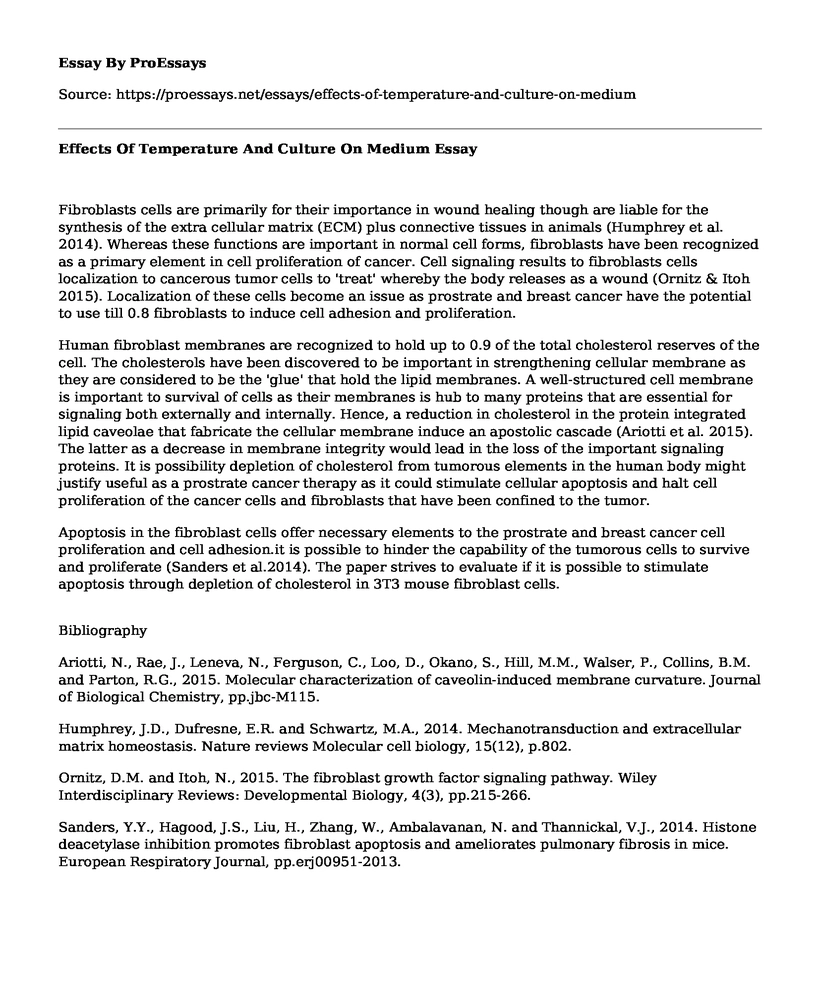Fibroblasts cells are primarily for their importance in wound healing though are liable for the synthesis of the extra cellular matrix (ECM) plus connective tissues in animals (Humphrey et al. 2014). Whereas these functions are important in normal cell forms, fibroblasts have been recognized as a primary element in cell proliferation of cancer. Cell signaling results to fibroblasts cells localization to cancerous tumor cells to 'treat' whereby the body releases as a wound (Ornitz & Itoh 2015). Localization of these cells become an issue as prostrate and breast cancer have the potential to use till 0.8 fibroblasts to induce cell adhesion and proliferation.
Human fibroblast membranes are recognized to hold up to 0.9 of the total cholesterol reserves of the cell. The cholesterols have been discovered to be important in strengthening cellular membrane as they are considered to be the 'glue' that hold the lipid membranes. A well-structured cell membrane is important to survival of cells as their membranes is hub to many proteins that are essential for signaling both externally and internally. Hence, a reduction in cholesterol in the protein integrated lipid caveolae that fabricate the cellular membrane induce an apostolic cascade (Ariotti et al. 2015). The latter as a decrease in membrane integrity would lead in the loss of the important signaling proteins. It is possibility depletion of cholesterol from tumorous elements in the human body might justify useful as a prostrate cancer therapy as it could stimulate cellular apoptosis and halt cell proliferation of the cancer cells and fibroblasts that have been confined to the tumor.
Apoptosis in the fibroblast cells offer necessary elements to the prostrate and breast cancer cell proliferation and cell adhesion.it is possible to hinder the capability of the tumorous cells to survive and proliferate (Sanders et al.2014). The paper strives to evaluate if it is possible to stimulate apoptosis through depletion of cholesterol in 3T3 mouse fibroblast cells.
Bibliography
Ariotti, N., Rae, J., Leneva, N., Ferguson, C., Loo, D., Okano, S., Hill, M.M., Walser, P., Collins, B.M. and Parton, R.G., 2015. Molecular characterization of caveolin-induced membrane curvature. Journal of Biological Chemistry, pp.jbc-M115.
Humphrey, J.D., Dufresne, E.R. and Schwartz, M.A., 2014. Mechanotransduction and extracellular matrix homeostasis. Nature reviews Molecular cell biology, 15(12), p.802.
Ornitz, D.M. and Itoh, N., 2015. The fibroblast growth factor signaling pathway. Wiley Interdisciplinary Reviews: Developmental Biology, 4(3), pp.215-266.
Sanders, Y.Y., Hagood, J.S., Liu, H., Zhang, W., Ambalavanan, N. and Thannickal, V.J., 2014. Histone deacetylase inhibition promotes fibroblast apoptosis and ameliorates pulmonary fibrosis in mice. European Respiratory Journal, pp.erj00951-2013.
Cite this page
Effects Of Temperature And Culture On Medium. (2022, Jun 23). Retrieved from https://proessays.net/essays/effects-of-temperature-and-culture-on-medium
If you are the original author of this essay and no longer wish to have it published on the ProEssays website, please click below to request its removal:
- Personal Essay Sample: My Biggest Mistake in Nursing Practice
- Essay Sample on Gun Violence in School
- The Acquisition of Prepositional Phrases Among Arab Learners of EFL
- Research Paper on Globalization Changes HR: Amazon & Beyond
- Children's Health: Vaccine Policies and Beyond - Essay Sample
- Essay Example on Abolishing Prisons: Freedom & Happiness Inside & Out
- Essay Example on Amelia Dyer: Notorious Female Serial Killer of 1800s Baby Farming







